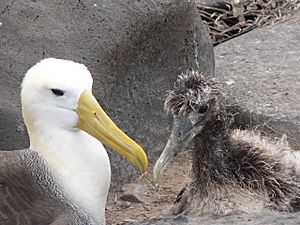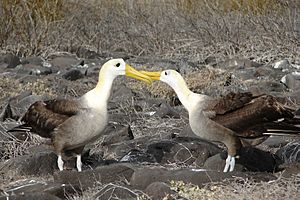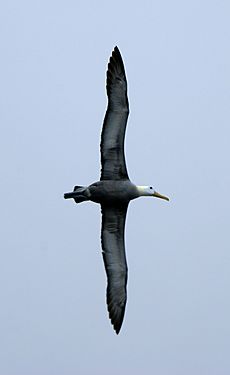Waved albatross facts for kids
Quick facts for kids Waved albatross |
|
|---|---|
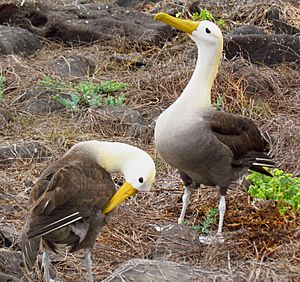 |
|
| Mated pair on Española Island, Ecuador | |
| Conservation status | |
| Scientific classification | |
| Genus: |
Phoebastria
|
| Species: |
irrorata
|
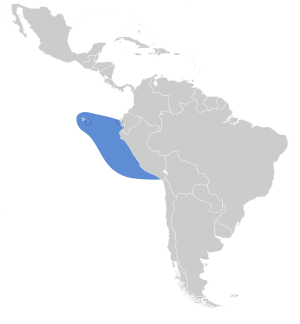 |
|
| Synonyms | |
|
Diomedea irrorata |
|
The waved albatross (Phoebastria irrorata), also known as the Galapagos albatross, is a special type of albatross. It's the only one in its family that lives in warm, tropical areas. These birds usually live along the coasts of Ecuador and Peru when they are not breeding. When they look for food, they fly straight to a specific spot off the coast of Peru, about 1,000 km (620 mi) away.
Contents
About the Waved Albatross
Waved albatrosses are part of a bird family called Diomedeidae. This family also includes other ocean birds like shearwaters and petrels. These birds have some unique features. For example, they have special nasal passages called naricorns on their upper bill, though the albatross's nostrils are on the sides. Their bills are also unique because they are made of seven to nine hard plates.
These birds can also make a special stomach oil. This oil is stored in their stomach and is used in two ways: to protect themselves from predators and as a rich food source for their chicks. Adults also use it for energy during their long flights. They also have a salt gland above their nose. This gland helps them remove extra salt from their bodies, which is important because they drink a lot of ocean water. They get rid of the salty solution through their nose.
Why They Are Called "Waved"
The waved albatross gets its name from the wavy patterns on the feathers of the adult birds.
What They Look Like
These are medium-sized albatrosses. They are about 80 to 90 cm (31 to 35 in) long and have a very wide wingspan of 220 to 250 cm (7.2 to 8.2 ft). They weigh between 2.7 and 4.0 kg (6.0 and 8.8 lb), with males usually being heavier than females.
They have a yellowish-cream neck and head, which stands out against their mostly brownish bodies. Their most noticeable feature is their very long, bright yellow bill. It looks quite large compared to their small head and long, thin neck. Their upper parts and underparts are chestnut brown with fine wavy lines, which are a bit rougher on their rump. Their upper-wings, back, and tail are brown, while their chest and underwings are whitish. They have brown armpits and bluish feet. Young albatrosses look similar to adults but have more white on their heads. Chicks are covered in soft brown fluffy feathers. These birds can live for a long time, sometimes up to 40 to 45 years.
Where They Live
The waved albatross mainly breeds on Española Island in the Galápagos archipelago. However, a small number, about 10 to 20, might also breed on Genovesa Island and Isla de la Plata. When it's not breeding season, they move east and southeast to the ocean area near the coasts of Peru and Ecuador. Sometimes, they are even seen in Colombia.
Behavior and Life Cycle
How They Find Food
Waved albatrosses mainly eat fish, squid, and crustaceans (like crabs and shrimp). They also sometimes eat smaller birds. They have been seen scavenging for other food, like food that other birds have spit up. When they hunt, waved albatrosses look for places in the ocean where their prey is close to the surface. This makes it easier for them to catch food. Parents will fly 10 to 100 km (6.2 to 62.1 mi) away from their nesting chicks to find food for them.
Reproduction and Breeding
Waved albatrosses build their nests on areas of lava rock with some boulders and not much plant life, or in thick bushes. Their courtship dance is amazing to watch! It involves fast bill circling, bowing, clacking their beaks together, and raising their bill to make a "whoo hoo" sound.
Eggs are laid between April and June and take about two months to hatch. Once the chicks hatch, they stay together in small groups while their parents go out to sea to hunt for food. When the parents return, they might feed the chicks up to 2 kg (4.4 lb) of oil. The young birds grow to adult size by December and leave the colony by January. Waved albatross partners stay together for life, until one of them dies.
How They Fly
Waved albatrosses are incredible flyers, perhaps even the best. They can fly for hours without stopping by using a technique called dynamic soaring. The wind speed near the ocean surface is much slower than it is about 15 m (50 ft) higher in the air. The waved albatross uses this difference to its advantage. It glides quickly into the wind. As it glides higher, it loses most of its speed relative to the ground because it's flying into a faster wind. However, its speed through the air doesn't drop, which allows it to glide continuously.
Even though they are great flyers, waved albatrosses have trouble landing because they need to fly fast to stay in the air. They also find it hard to take off because of their huge wings. To make it easier, they sometimes take off from cliffs that are a bit inland, rather than right by the coast.
Conservation Efforts
The waved albatross population in the Galápagos is protected by national park staff, and the island is also a World Heritage Site. However, these birds face many dangers. Their small living area, getting caught by accident in longline fishing nets, disturbances from tourists, diseases, and illegal fishing in nearby waters all put them at risk.
Longline fishing seems to be a big problem for them. Because of these threats, their conservation status was changed from "near threatened" to "vulnerable" by the IUCN in 2000.
Even though there were about 34,700 adult birds in 2001, their numbers have started to drop more recently. This is likely due to longline fishing, which also affects the number of males and females (more males are being killed). Because of this situation, the population is at high risk of a sudden collapse leading to extinction. So, in 2007, their status was changed again to "critically endangered" on the IUCN Red List.
In 1970 and 1971, there were an estimated 24,000 waved albatrosses. By 1994, there were between 31,200 and 36,400. The 2001 estimate was 34,700 adult birds. This species lives across a very large area of about 1,750,000 km2 (675,679 sq mi), but their breeding area is much smaller, only about 9 km2 (3.5 sq mi).
Gallery
See also
 In Spanish: Albatros de las Galápagos para niños
In Spanish: Albatros de las Galápagos para niños



